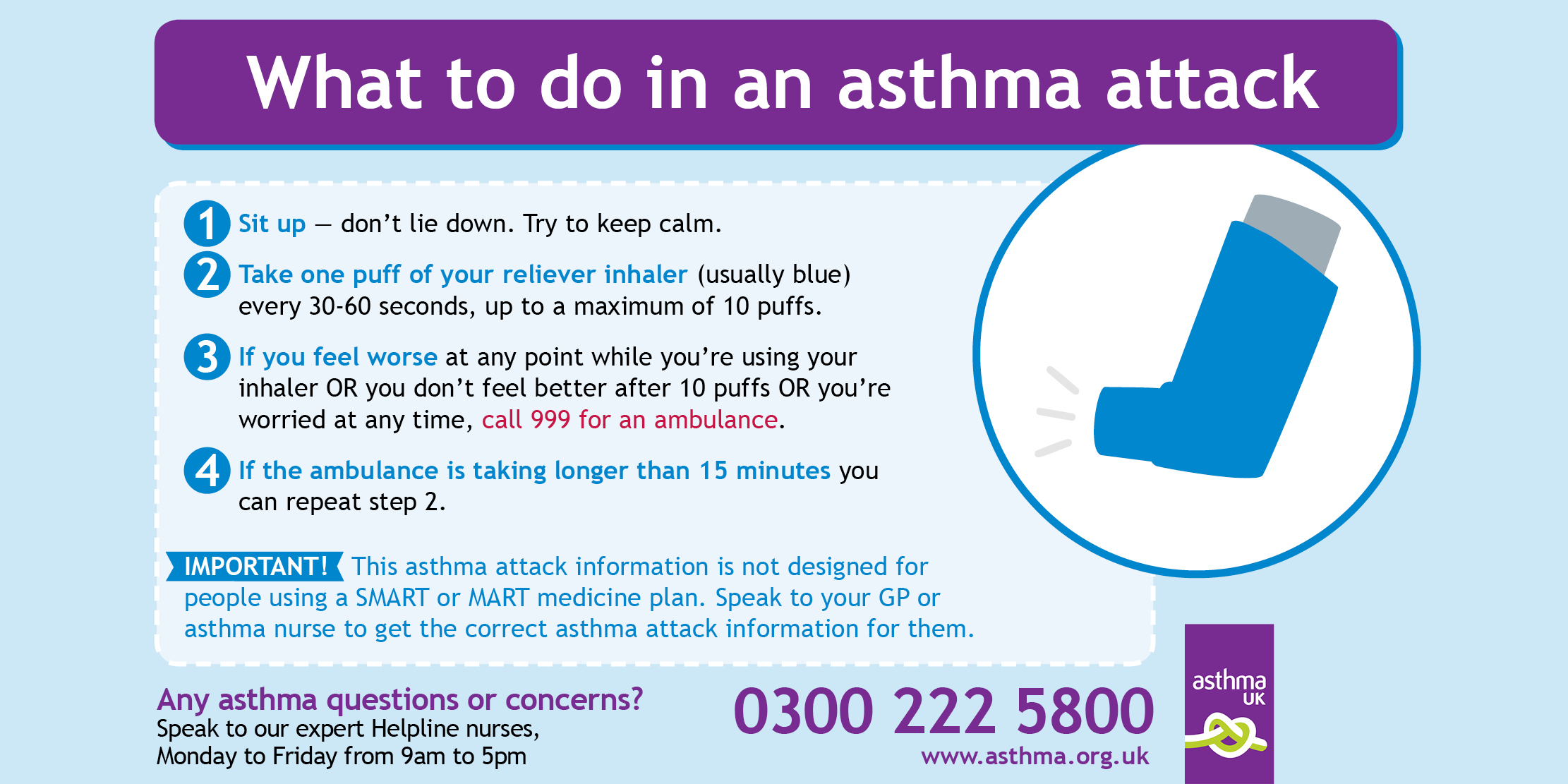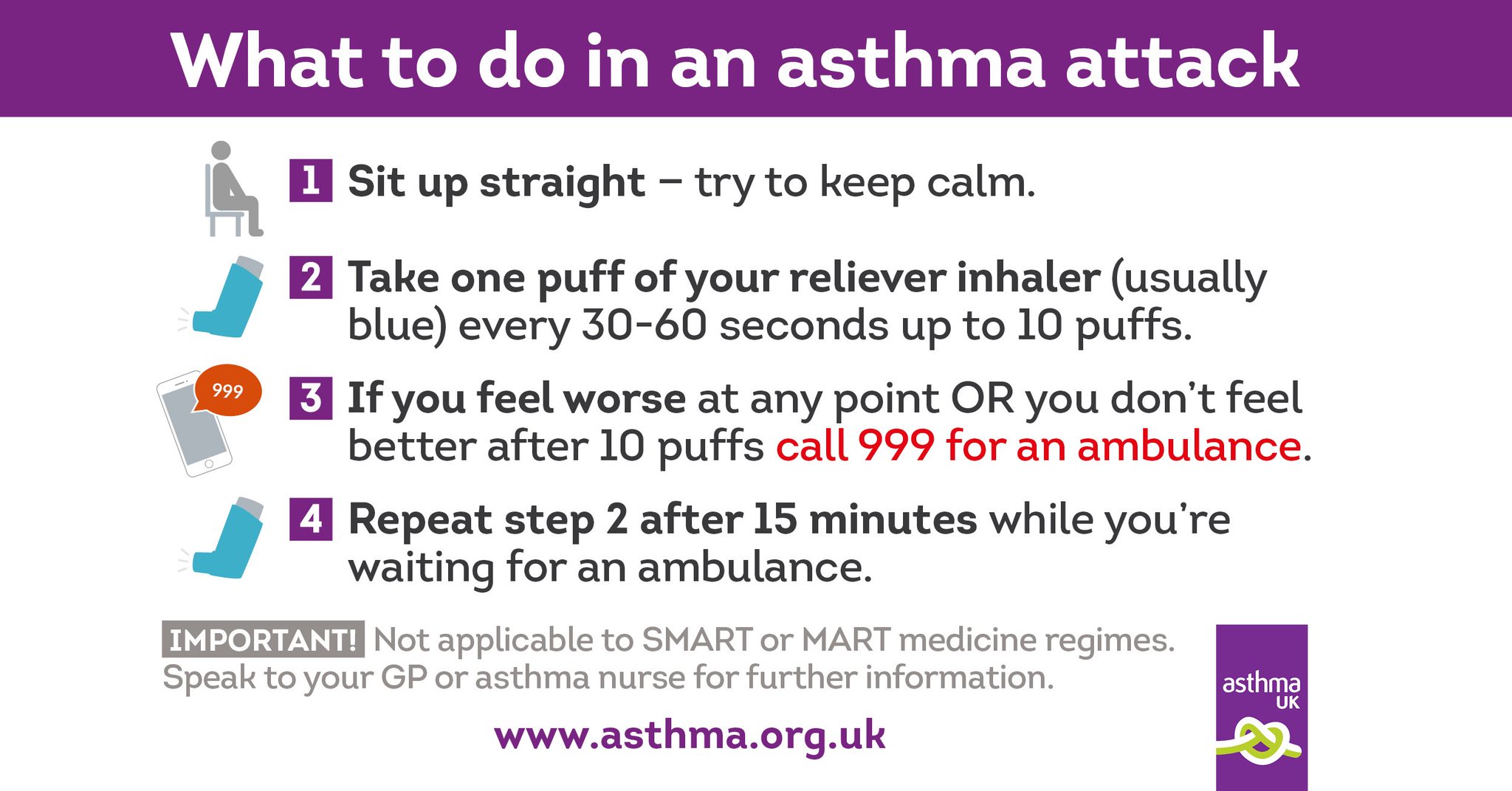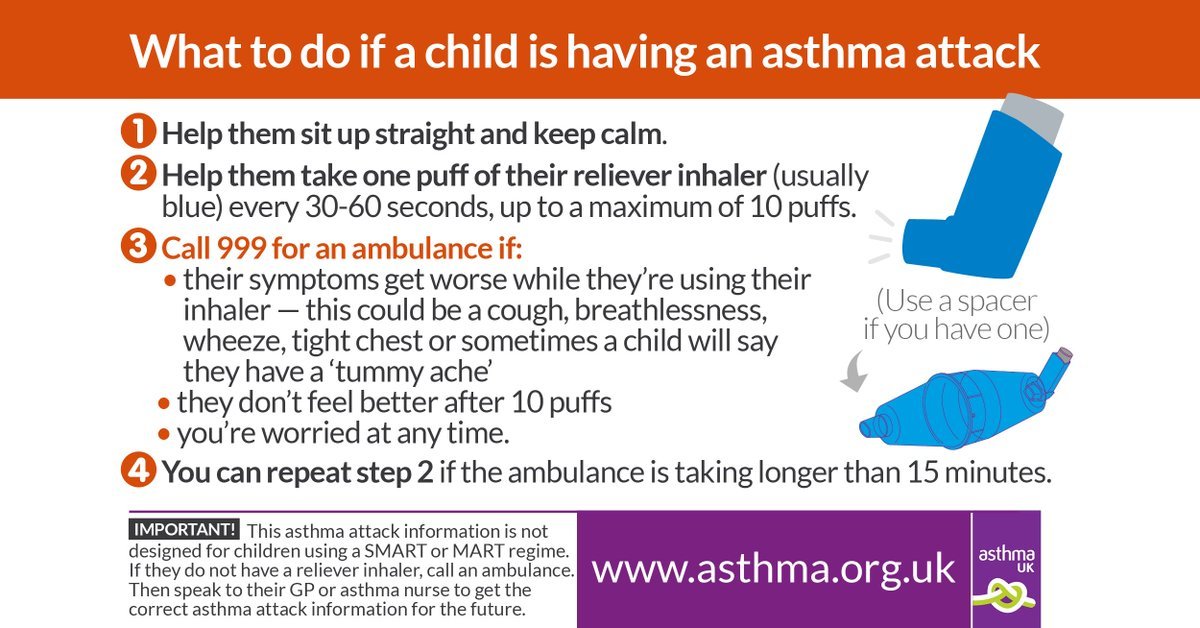Personal And Family History
- Gender. Among children, boys have asthma more often than girls.
- Race. Asthma is more common in black children than in white children.footnote 2
- Bronchial tubes that overreact. Children who inherit a tendency of the bronchial tubes to overreact often develop asthma.
- A history of allergies, including food allergies. Children who have an allergy are more likely than other children to develop asthma. Most children with asthma have allergic rhinitis, atopic dermatitis, or both. Studies show that 40 to 50 out of 100 children who have atopic dermatitis develop asthma. Having atopic dermatitis as a child may also increase the risk of a person having more severe and persistent asthma as an adult.footnote 3
- A family history of allergies and asthma. Children who have an allergy and asthma usually have a family history of allergies or asthma.
- Respiratory syncytial virus and wheezing at a young age. Early infection with respiratory syncytial virus that causes a lower respiratory infection increases a child’s risk for wheezing.footnote 4 Young children who wheeze have a greater risk for asthma than children who do not wheeze.
How Do I Treat My Childs Asthma Attack
You will need to use the blue inhaler with a plastic tube called a spacer.
- give 2 puffs of the blue inhaler, one puff at a time, using the spacer, every 4 hours
- for each puff of the blue inhaler, your child will need to take 6 breaths through the spacer
If your child is still not improving:
- you can give up to 6 puffs of the blue inhaler every 4 hours
You need to take your child to your family doctor, or an after-hours clinic, or the hospital:
- if you need to give the blue inhaler more often than every 2 hours
- if there is no improvement 30 minutes after giving 6 puffs of the blue inhaler
After An Asthma Attack: What To Do At Home
How quickly you recover at home depends on how severe your attack was and what triggered it, said Khatri. If your attack was caused by an irritant, you should recover quickly. If your attack was caused by an infection, it may take a few days. In either case, you should follow all of your doctors instructions, keep your follow-up appointments, rest, and drink plenty of fluids as you gradually return to normal activities.
However, you should get some help for an asthma attack or after an asthma attack if:
- Your asthma symptoms get worse
- Your peak flow numbers are not getting better or are going down
- You are struggling to walk or talk because of trouble breathing
- You are struggling to breathe
- Your quick-relief medicine is not helping
- Your lips or fingernails turn blue
Read Also: What Helps With Asthma Besides An Inhaler
More Tips For Managing Your Child’s Asthma
To manage your child’s asthma:
- Stay with a daily routine. Make treatment part of normal, daily activities to help your child adjust to the condition and take responsibility for managing treatment. Your child could, for example, get used to taking medicine before brushing his or her teeth.
- Check your child’s symptoms. If your child is old enough to understand the process, teach him or her what symptoms to watch for. Help your child understand how to follow his or her asthma action plan.
- Inform others in your child’s life about asthma. Inform the principal, school nurse, teachers, and coaches at your child’s school that your child has asthma. Give the staff a copy of your child’s asthma action plan so that they can help your child to take his or her medicine and will know what to do during an asthma attack. Encourage your child to participate in exercise and sports. Asthma, when well controlled, should not prevent your child from participating in sports and other physical activities.
It is important to treat your child’s asthma attacks quickly. If your child does not improve soon after treating an attack, talk with a doctor.
- During attacks, stay calm and soothe your child. This may help your child relax and breathe more easily.
- Don’t underestimate or overestimate how severe your child’s asthma is. It is often hard to know how much breathing difficulty a baby or small child is having. Seek medical care early for babies and small children who have asthma symptoms.
What To Expect When You Visit The Doctor

Your doctor may ask whether you have any family history of asthma, eczema or hay fever.
In children, doctors assess the severity of the asthma based on the pattern and frequency of the symptoms.
Lung function tests are difficult to perform in children younger than 5 years and so are usually only used to diagnose and assess severity in children 5 years and older.
It is recommended that a paediatrician or paediatric respiratory specialist diagnose and manage asthma in infants under 12 months. If your infant is wheezing your doctor should refer to you one of these specialists.
You May Like: Coffee For Asthmatics
Everyday Treatment For Asthma In Children
The main aims of day-to-day asthma treatment are to:
- keep symptoms under control
- keep lungs as healthy as possible
- stop asthma from interfering with school or play
- help your child enjoy a full and active life.
Your doctor will help you to develop a plan to manage your childs asthma which will include an asthma action plan , and will prescribe the correct medication to help you do so.
How To Tell You Have Asthma
In this section: Diagnosis and Lung Testing | How To Tell You Have Asthma | Your Healthcare Team
Asthma is a complex disease to diagnose, and only a healthcare professional is able to make a proper .
If you are concerned that you may have asthma, contact your healthcare provider. In order to confirm an asthma diagnosis, your healthcare provider will take into account your medical and family history, allergies, and conduct lung function testing such as spirometry.
Also Check: How To Get Rid Of Asthma Without Inhaler
How To Help Someone Having An Asthma Attack
This article was medically reviewed by Daniel Wozniczka, MD, MPH. Dr. Wozniczka is an Internal Medicine Physician in Chicago, with global healthcare experience in Sub Saharan Africa, Eastern Europe, and Southeast Asia. He completed his MD at Jagiellonian University in 2014, and also holds an MBA and Masters in Public Health from the University of Illinois at Chicago.There are 11 references cited in this article, which can be found at the bottom of the page. This article has been viewed 20,530 times.
Having an asthma attack can be frightening. It can also be frightening to see someone you know, or even a stranger, have an asthma attack. The person may be panicking, especially if they do not have their inhaler. Fortunately, you can help! Assist someone having an asthma attack by getting the appropriate medical assistance, helping them to remain calm, and using simple techniques to help improve their breathing.
Other Things That Increase Your Child’s Risk
- Secondhand cigarette smoke. Children who are around secondhand cigarette smoke are at increased risk for developing asthma.footnote 5 If children already have the disease, secondhand smoke increases the severity of their symptoms.
- Cigarette smoking. Children who smoke are more likely to develop asthma when they become teenagers. A large study found that children who smoked at least 300 cigarettes in a year were almost 4 times more likely to get asthma.footnote 6
- Cigarette smoking during pregnancy. Women who smoke during pregnancy increase the risk of wheezing in their babies. Babies whose mothers smoked during pregnancy also have worse lung function than babies whose mothers did not smoke.footnote 5
- Obesity. Studies have found a link between obesity in children and a higher-than-average asthma prevalence. But the reason for the link is unclear.footnote 2 Also, symptoms caused by obesity are sometimes thought to be asthma symptoms.
- Dust mites. Being around dust mites may increase your child’s risk for asthma.footnote 5
- Cockroaches. In one study, children who had a high level of cockroach droppings in their home were 4 times more likely to have a new diagnosis of asthma than children whose homes have a low level.footnote 5
You May Like: Can You Die In Your Sleep From Asthma
Side Effects Of Asthma Medication
If you are worried about possible side effects from asthma medication, speak to your doctor. Do not stop or reduce doses of medication for your child without speaking with your doctor. Common side effects from inhaled asthma medication:
Preventers
- sore mouth and throat
- fungal throat infections.
Using a spacer reduces the risk of these side effects. as does rinsing the mouth with water after using an inhaler.
Relievers
- fast heart beat.
What Is An Asthma Trigger
A trigger is anything that irritates your airways. Asthma is caused by two types of triggers.
- Allergic trigger: cause allergic reactions. Allergic triggers include things like dust mites, pollens, moulds, pet dander,
- Non-allergic trigger: are usually irritants. Non-allergic triggers include things like smoke, cold air, certain air pollutants, intense emotions
Learn more about different types of asthma triggers and how to manage them.
Read Also: What Is The Blood Test For Eosinophilic Asthma
What Does Asthma Feel Like
Asthma is marked by inflammation of the bronchial tubes, with extra sticky secretions inside the tubes. People with asthma have symptoms when the airways tighten, inflame, or fill with mucus.
There are three major signs of asthma:
- Airway blockage. When you breathe as usual, the bands of muscle around your airways are relaxed, and air moves freely. But when you have asthma, the muscles tighten. Itâs harder for air to pass through.
- Inflammation. Asthma causes red, swollen bronchial tubes in your lungs. This inflammation can damage your lungs. Treating this is key to managing asthma in the long run.
- Airway irritability. People with asthma have sensitive airways that tend to overreact and narrow when they come into contact with even slight triggers.
These problems may cause symptoms such as:
- Coughing, especially at night or in the morning
- Wheezing, a whistling sound when you breathe
- Shortness of breath
- Trouble sleeping because of breathing problems
Not every person with asthma has the same symptoms in the same way. You may not have all of these symptoms, or you may have different symptoms at different times. Your symptoms may also vary from one asthma attack to the next, being mild during one and severe during another.
Some people with asthma may go for long periods without having any symptoms. Others might have problems every day. In addition, some people may have asthma only during exercise or with viral infections like colds.
When to see your doctor
Other Asthma Triggers: Workplace Triggers Food Triggers

Some people have asthma triggers at work things like smoke, fumes, or cold air. If your asthma is triggered by something at work, you have work-exacerbated asthma. Most peoples asthma triggers are inhaled . But for some people, asthma symptoms can be triggered by things they eat, drink, or swallow. These are some other asthma triggers:
- sulphites, chemicals used to preserve some food, like dried fruit and red wine
- MSG , a flavour enhancer use in food
- Aspirin
Some people with asthma also have food allergies. People with any allergy that causes anaphylactic shock should keep their epinephrine kit with them at all times.
Don’t Miss: How To Help Asthma Attack Without Inhaler
When To See Your Doctor
- severe trouble breathing, such as rapid breathing, indrawing of muscles between their ribs when inhaling, and grunting when exhaling
- blue lips or fingertips, darkened skin
- chest, throat or neck pain
- fever and constant coughing or wheezing that doesnt respond to prescribed medicines
- vomiting that wont allow them to take oral medicine.
Also see your doctor if your child has asthma and is uneasy, drowsy, confused or lethargic .
Triggers For Asthma In Children
Asthma triggers are substances, conditions or activities that lead to asthma symptoms. These include :
- wheezing whistling noise when breathing
- coughing .
Your child may have all of these symptoms or just a few. Symptoms are often worse at night, in the early morning, during exercise or due to other triggers.
Don’t Miss: Does Albuterol Make You Gain Weight
What Are The Symptoms Of Asthma
Your child might have asthma if they suddenly have trouble breathing, and cough or make a wheezy sound when they breathe. They are likely to talk about how they feel or appear distressed. A severe asthma attack is very upsetting because your child will feel that they are unable to get enough air.
Symptoms and signs to be aware of include:
- coughing , which might be the only sign
- wheezing and shortness of breath
- chest tightness
- breathing feeling ‘tight’, lethargy or lack of interest in physical activity
Get urgent medical attention if your child has any of the following symptoms and signs:
- difficulty breathing, seen as rapid breaths, inward movement of the chest wall while breathing in, and grunting while breathing out
- inability to speak
- constant coughing or wheezing that does not respond to prescribed medicines
Childhood Vs Adult Symptoms
Children and adults generally have similar symptoms. But, identifying asthma symptoms in children can be more difficult, especially in younger children who may not be able to tell you how they are feeling.
Here are some things to watch for in your child that could indicate asthma:
- Not being able to keep up with other children while running around
- Having a hard time catching their breath or breathing faster than other children who are doing the same thing
- Looks like they have a cold, which could actually be asthma
- Coughing, especially at night
- Feel restless, irritable and/or very tired
What to do:
STEP 1: Immediately use a fast-acting reliever inhaler . Use a spacer if provided.STEP 2: Check your symptoms. If they are gone, you can go back to your normal activities. If they symptoms get worse or do not improve within 10 minutes, this is an emergency. Follow the steps below.
Read Also: What Is The Blood Test For Eosinophilic Asthma
Learn First Aid For Someone Who Is Having An Asthma Attack
1. Help the person sit in a comfortable position and take their inhaler.
When someone has an asthma attack, their airways narrow, making it difficult for them to breathe. An inhaler relaxes the muscles, allowing the airways to expand and ease their breathing.
2. Reassure the person. If the attack becomes severe, or they dont have their inhaler, call 999 as soon as possible.
A mild attack should ease within a few minutes. If it doesnt, they can continue to take their inhaler. You should call 999 if they they dont have their inhaler, their inhaler has no effect, they are becoming worse or they become unable to talk. Do not leave them, in case the attack becomes severe quickly. If you cant call 999, get someone else to do it.
How Is It Treated
There are two parts to treating asthma, and they are outlined in the asthma action plan. The goals are to:
- Control asthma over the long term. The asthma action plan tells you which medicine your child needs to take. It also helps you track your child’s symptoms and know how well the treatment is working. Many children take controller medicineâusually an inhaled corticosteroid medicineâevery day. Taking controller medicine every day helps reduce the swelling of the airways and helps prevent attacks.
- Treat asthma attacks when they occur. The asthma action plan tells you what to do when your child has an asthma attack. It helps you identify triggers that can cause your child’s attacks. Your child will use quick-relief medicine, such as albuterol, during an attack.
If your child needs to use quick-relief medicine on more than 2 days a week, talk to your doctor. This is a sign that your child’s asthma is not controlled and can cause problems.
Asthma attacks can be life-threatening, but you may be able to prevent them if you follow a plan. Your doctor can teach you the skills you need to use your child’s asthma action plan.
Recommended Reading: What To Do Without Inhaler
Actions To Take If Your Child Has An Asthma Attack
What Happens During A Flare

Children with asthma have severe episodes or flare-ups when the air passages in their lungs become narrower. This makes it harder to breathe. Sensitive airways react to certain things called triggers. Triggers can cause:
-
The lining of the airways to become more inflamed and swollen
-
Tightening of the muscles that surround the airways
-
More mucus production
-
Less air movement through the lungs
Your child may have the following symptoms of a flare-up:
-
It may become harder to breathe. Your child may start breathing faster than normal. They may use muscles that they normally don’t use to breathe. This will make it look like the area under or between the ribs is sucking in or the belly is sticking out.
-
Chest tightness
-
Wheezing or whistling when breathing out. Wheezing may not happen with very severe flare-ups.
-
Symptoms that wake your child or keep them from sleeping
-
Trouble walking or talking
Make sure you know what to do if your child’s symptoms get worse. Always have his or her asthma medicines and asthma action plan available to use in case of a flare-up. If your child does not get treatment right away during a flare-up, they could stop breathing, or even die.
Don’t Miss: Steam Helps Asthma
